|

|
|
|
|
about us |
|
|
see the beast |
|
|
our photo album |
|
|
explore tucson |
|
|
links |
|
|
email us |
|
|
sign our guest book |
|
|
home |
|
www.davidandcarol.com |
|
Our Magnificent Journey |
|
Chapter 13 |
|
2011 |
|
Greece, Turkey and Spain |
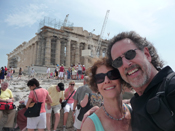 |
|
Slept incredibly well and woke at 7 am. Enjoyed breakfast at the hotel – eggs, cheese, fruit, sweet rolls, juice and coffee. |
At 10 am we walked a few blocks east to Plaza Catalunya where we jumped on the Hop-on/Hop off “Barcelona Tour” red double-decker bus. For the next 2.5 hours we sat comfortably in the open air on the second deck and listened through headphones as an English-speaking narrator explained the many important sights around Barcelona. |
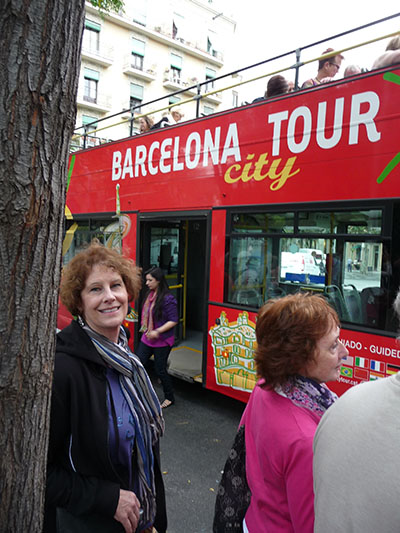 |
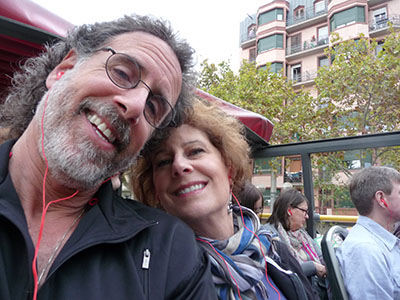 |
Along the way, we hopped off at the incredible moderniste/gothic masterpiece of Antonio Gaudi’s Sagrada Familia, whose unique towering spires draw your eyes up to the sky. Spent some time there snapping photos and mingling among the thousands of other tourists there. |
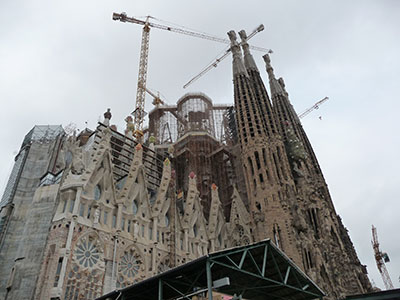 |
The Basílica i Temple Expiatori de la Sagrada Família, commonly known as the Sagrada Família, is a large Roman Catholic church designed by Catalan architect Antoni Gaudí (1852–1926). Although incomplete, the church is a UNESCO World Heritage Site, and in November 2010 was consecrated and proclaimed a minor basilica by Pope Benedict XVI. Though construction of Sagrada Família had commenced in 1882, Gaudí became involved in 1883, taking over the project and transforming it with his architectural and engineering style—combining Gothic and curvilinear Art Nouveau forms. Gaudí devoted his last years to the project, and at the time of his death in 1926, less than a quarter of the project was complete. Sagrada Família's construction progressed slowly, as it relied on private donations and was interrupted by the Spanish Civil War—only to resume intermittent progress in the 1950s. Construction passed the midpoint in 2010 with some of the project's greatest challenges remaining and an anticipated completion date of 2026—the centennial of Gaudí's death. The basílica has a long history of dividing the citizens of Barcelona—over the initial possibility it might compete with Barcelona's cathedral, over Gaudí's design itself, over the possibility that work after Gaudí's death disregarded his design, and the recent possibility that an underground tunnel of Spain's high-speed train could disturb its stability. The Sagrada Familia has been called 'the most extraordinary personal interpretation of Gothic architecture since the Middle Ages'. |
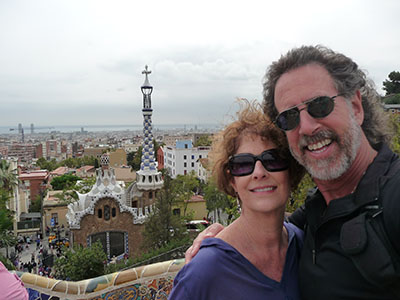 |
Hopped back on the bus for a while and then hopped off at Gaudi’s incredible Parc Guell. Declared a Unesco world heritage site in 1984, this heady brew of architectural wizardry includes trencadis tiling, a serpentine bench, fairy-tale pavilions, gothic archways and an ornate dragon. In true Gaudi style, playfulness and symbolism pervade every aspect of the park. The views of Barcelona and the Mediterranean Sea beyond from the high vantage point of Gaudi’s whimsical park are unexcelled. |
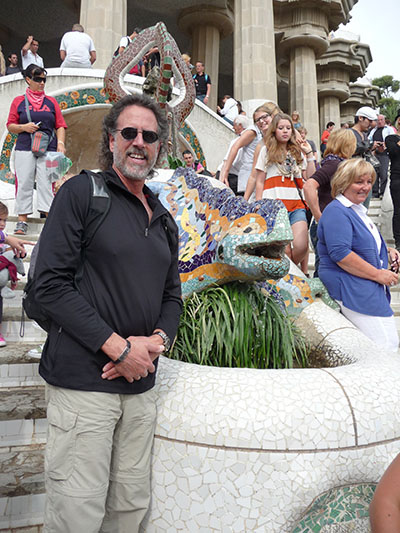 |
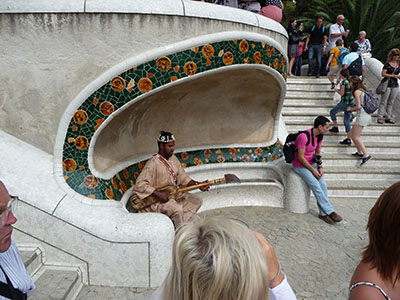 |
Jumped off the bus at La Padrena and walked several blocks south to Casa Batlló on Passeig de Gràcia. |
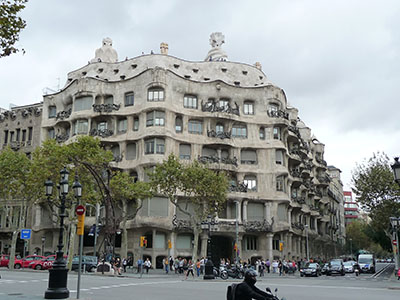 |
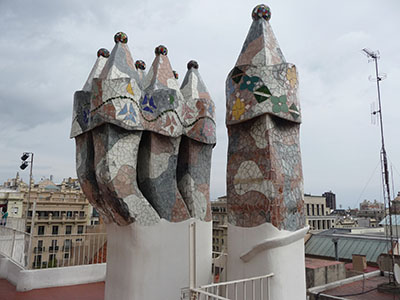 |
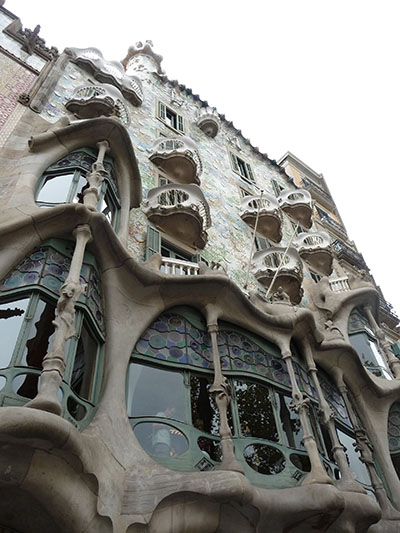 |
Casa Batlló is a building restored by Antoni Gaudí and Josep Maria Jujol, built in 1877 and remodelled in the years 1904–1906; located at 43, Passeig de Gràcia (passeig is Catalan for promenade or avenue), part of the Illa de la Discòrdia (the "Block of Discord") in the Eixample district of Barcelona. The local name for the building is Casa dels ossos (House of Bones), as it has a visceral, skeletal organic quality. It was originally designed for a middle-class family and situated in a prosperous district of Barcelona. The building looks very remarkable — like everything Gaudí designed, only identifiable as Modernisme or Art Nouveau in the broadest sense. The ground floor, in particular, is rather astonishing with tracery, irregular oval windows and flowing sculpted stone work. It seems that the goal of the designer was to avoid straight lines completely. Much of the façade is decorated with a mosaic made of broken ceramic tiles (trencadís) that starts in shades of golden orange moving into greenish blues. The roof is arched and was likened to the back of a dragon or dinosaur. A common theory about the building is that the rounded feature to the left of centre, terminating at the top in a turret and cross, represents the lance of Saint George (patron saint of Catalonia, Gaudi's home), which has been plunged into the back of the dragon. |
After touring Gaudi’s magnificent Casa Batlló, we stopped at an outdoor café for a small lunch of olives, bread, cold tomato soup with mozzarella cheese, tabouli with sardines in a light citrus sauce and local sparkling water. Delicious! |
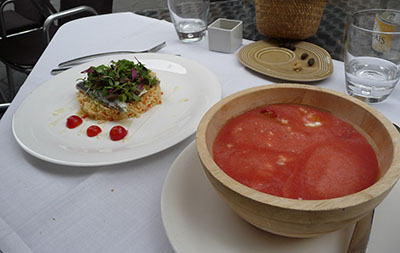 |
After our respite we continued walking south to bustling La Rambla in search of Mercat de Sant Josep de la Boqueria. We found this enormous, busy market off one of the side streets and spent an hour wandering its many stalls offering fish, meats, cheeses, chocolate, fruits and wines. A cacophonous shrine to food, this cavernous market is a must-see. |
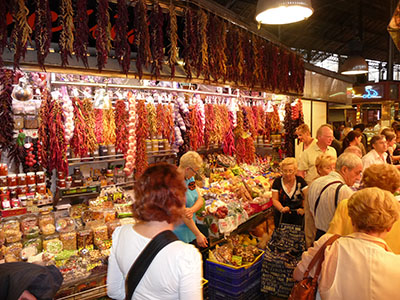 |
We walked back, exhausted, to the hotel at 5 pm and made reservations for La Clara, a nearby restaurant recommended by the hotel concierge for its authentic Catalonian food. |
At 8 pm we walked through the cool Barcelona evening towards La Clara, 7 blocks west of the hotel. A light rain had fallen and washed away the grit of the day. The city seems renewed, clean and fresh, and we enjoyed walking slowly, arm-in-arm, down the wide, safe pedestrian walkway. Barcelona’s city planners came up with an ingenious plan to accommodate pedestrians and vehicle traffic exceptionally well. Barcelona strikes us as a city intended for pedestrians. |
Arrived at La Clara for our 8:30 pm reservation. We were directed to our table in the large downstairs dining room. We are the first diners. The Barcelona “evening” doesn’t start until later, but by the time we left, the place was full and hopping. We were the only Americans - perhaps the only tourists - in the restaurant; a truly authentic dining experience for which we greatly owe our young hotel concierge. |
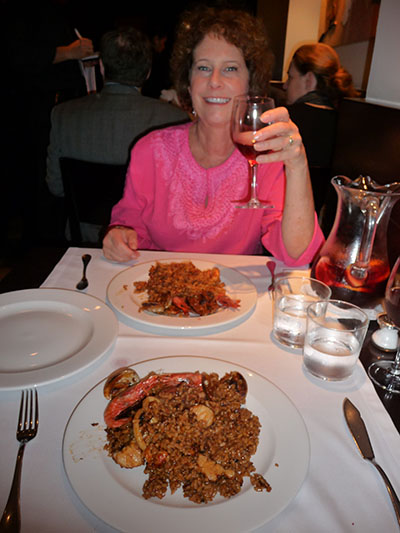 |
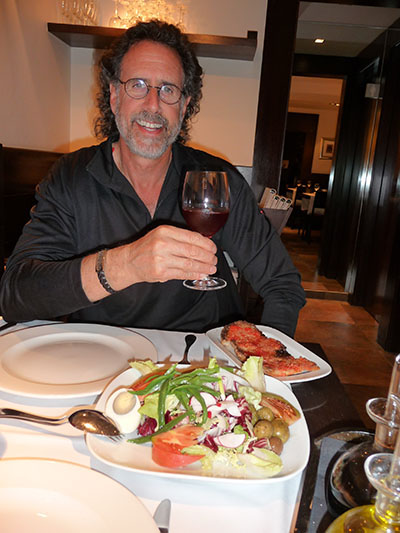 |
We ordered fresh green salad, toast with oil and tomato, seafood paella, sangria and flan with orange. The dinner, in this upscale and authentic Catalonian restaurant was outstanding – one of the most memorable of our entire trip. The seafood paella was moist, crunchy and full of delectable treats from the sea. The rice was perfect. Don’t miss this one. |
At 10:30 pm, totally and delightfully sated, we slowly walked along the pedestrian-friendly Gran Via de las Corte Catalanes to the hotel, profusely thanked our young concierge for the terrific gastronomic suggestion, took the elevator to the 6th floor and fell asleep before our heads hit the pillows. Although we’ve had limited time in this incredible and important Spanish city on the Mediterranean, we feel like we’ve come to know her and we will surely miss her and her exquisite charms. |
| Previous Day |
copyright 1998 / david
and carol lehrman / all rights reserved |
email david@davidandcarol.com |